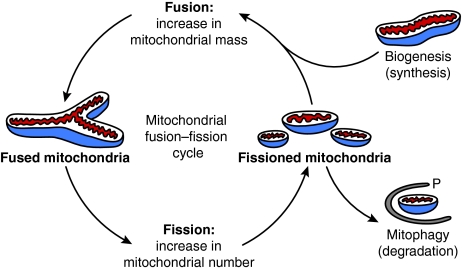Fig. 3.
Possible relationship between mitochondrial fusion, fission, biogenesis and degradation. An ongoing mitochondrial fusion–fission cycle allows mitochondrial functional and genetic complementation, and the proper distribution of newly synthesized mitochondria during cell division. However, an imbalance in fusion and fission events – for example, more frequent fission than fusion – might increase the total number of small mitochondria per cell if extra mitochondria are not eliminated by mitophagy. Conversely, more frequent fusion could result in large tubular networks of mitochondria. Mitochondrial biogenesis is required to compensate for decreased mitochondrial biomass resulting from mitochondrial degradation (Berman et al., 2009). Therefore, an imbalance between mitochondrial fusion, fission, biogenesis and degradation events could cause substantial changes in mitochondrial number, biomass, shape and function. P indicates a phagophore by which targeted mitochondria are engulfed during the sequestering process required for mitophagy.

